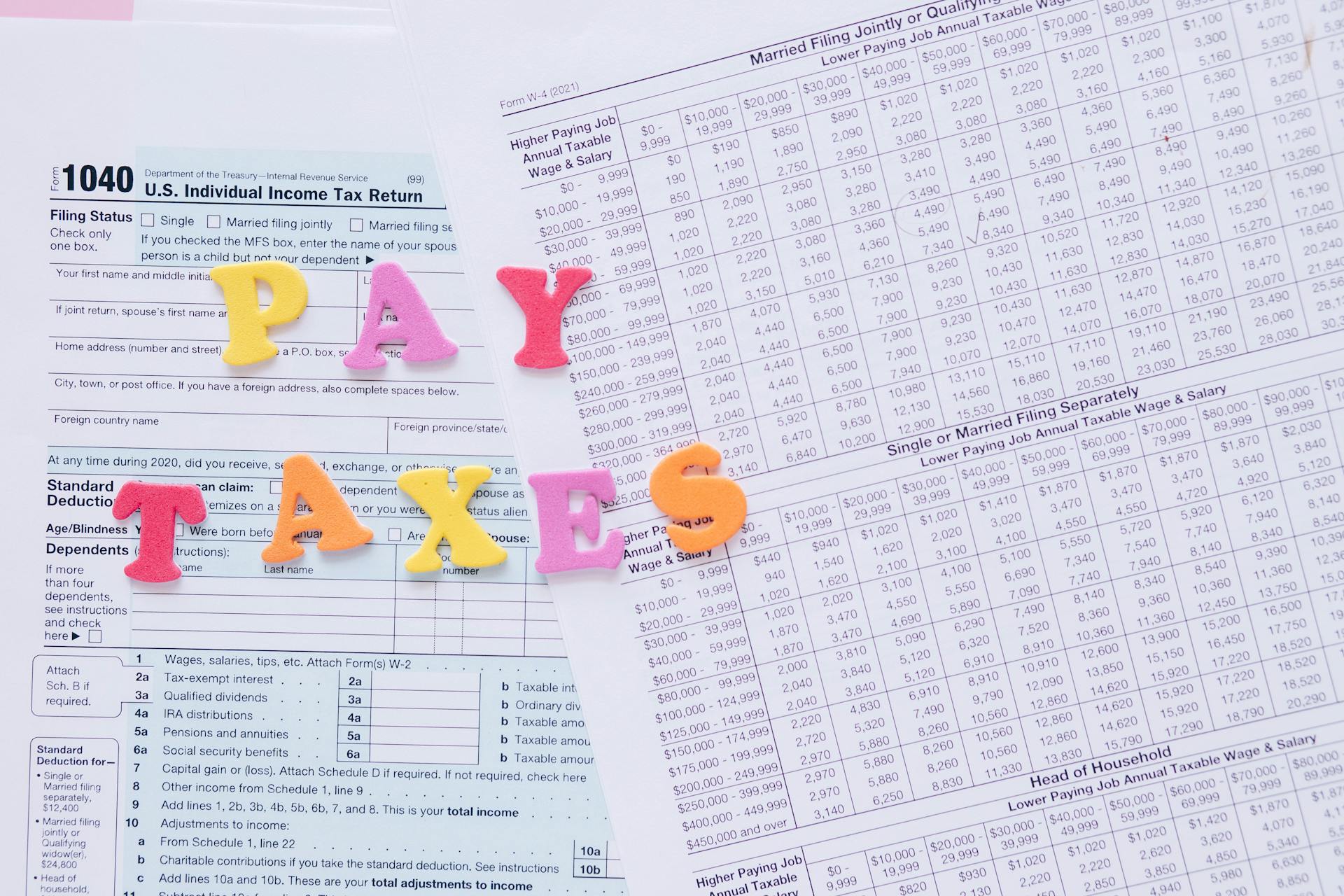
Tax deferred contribution plans are a great way to save for retirement and other long-term goals. They allow you to contribute a portion of your income to a plan, and the earnings grow tax-free until withdrawal.
One of the key benefits of tax deferred contribution plans is that they can help reduce your taxable income for the year. This can be especially helpful for high-income earners who are looking to minimize their tax liability.
Tax deferred contribution plans can include 401(k), 403(b), and Thrift Savings Plan accounts, which are commonly offered by employers. These plans allow you to contribute a portion of your income to a retirement account, and the earnings grow tax-free until withdrawal.
You can contribute up to $19,500 to a 401(k) or 403(b) plan in 2022, and an additional $6,500 if you are 50 or older.
Curious to learn more? Check out: Benefits of 457 Plan
Retirement Plans
Traditional 401(k) plans offer tax-deductible employee contributions, tax-deferred employer contributions and earnings, and withdrawals in retirement subject to income tax.
Consider reading: Solo 401k after Tax Contributions
Roth 401(k) plans, on the other hand, require contributions to be made with after-tax dollars, but employer contributions and earnings grow tax-free, and qualified withdrawals in retirement are tax-free.
Defined benefit plans, also known as traditional pensions, provide a fixed benefit in retirement based on factors like salary and years of service, with contributions and earnings growing tax-deferred.
Roth IRAs allow earnings to grow tax-free, and qualified withdrawals in retirement, including earnings, are tax-free.
Simplified Employee Pension (SEP) IRAs are designed for self-employed individuals and small businesses, with tax-deductible contributions and earnings growing tax-deferred.
Governmental 457 plans and certain non-governmental 457 plans operate similarly to 401(k) plans, with tax-deferred contributions and withdrawals in retirement subject to income tax.
Here's a summary of the key features of these retirement plans:
Tax Benefits
Tax benefits of tax-deferred contributions are numerous and can significantly impact your retirement savings. You can reduce your taxable income now by contributing to a tax-deferred 401(k) plan. This can lower your income tax bill today.

For example, if you contribute 6% of your salary to a tax-deferred 401(k), your taxable income is reduced, and you pay less income tax. Let's assume your salary is $35,000 and your tax bracket is 25%. Your taxable income would be $32,900, resulting in $525 less in income tax.
You can also benefit from the Saver's Credit, which directly reduces your tax bill by a portion of the amount you put into your 401(k). This credit can be up to $2,000, depending on your income and filing status.
Here are some tax benefits of tax-deferred contributions:
- Tax-deferred 401(k)s reduce taxable income now
- Saver's Credit can be up to $2,000
- Contributions to a Roth 401(k) are after-tax contributions, but earnings grow tax-free
- Qualified withdrawals in retirement are tax-free
Tax-deferred interest with 401(k)s can also save you money in taxes. If you contribute $100 a month into a traditional 401(k) that earns 8%, you could amass more than $150,000 of tax-free retirement savings over 30 years and save almost $50,000 in taxes.
In contrast, after-tax 401(k) contributions are made with money you've already paid taxes on, but they can grow tax-free and provide tax-free withdrawals in retirement. However, not all 401(k) plans allow after-tax contributions.
Ultimately, understanding the tax benefits of tax-deferred contributions can help you make informed decisions about your retirement savings.
Related reading: Tfsa Tax Free
Roth IRA

A Roth IRA is a type of tax-advantaged retirement account that allows your earnings to grow tax-free.
You can contribute to a Roth IRA with after-tax dollars, meaning you've already paid income tax on the money.
Earnings within a Roth IRA grow tax-free, and qualified withdrawals in retirement are tax-free as well.
You can withdraw your contributions to a Roth IRA at any time without penalty or taxes.
Here are some key benefits of a Roth IRA:
- Earnings grow tax-free
- Qualified withdrawals in retirement are tax-free
- Contributions can be withdrawn at any time without penalty or taxes
401(k) Details
A 401(k) plan is a type of tax-deferred retirement account that allows you to save for your future while reducing your taxable income today.
You can contribute to a 401(k) through your employer, and the contributions are typically tax-deductible, meaning you won't pay taxes on them until you withdraw the funds in retirement.
There are two main types of 401(k) plans: traditional and Roth. With a traditional 401(k), your contributions are tax-deductible, but you'll pay taxes on withdrawals in retirement. A Roth 401(k), on the other hand, requires you to pay taxes on your contributions upfront, but the earnings grow tax-free and withdrawals are tax-free in retirement.
Expand your knowledge: How to Pay Business Taxes

The main appeal of a Roth 401(k) is that qualified withdrawals are tax-free, which can be a significant advantage in retirement.
You can also make after-tax contributions to a 401(k), which means you've already paid taxes on the money and are putting it into the account to save for retirement. This type of contribution grows tax-free and withdrawals are tax-free in retirement.
Here are some types of 401(k) plans:
- Traditional 401(k)
- Roth 401(k)
- SIMPLE 401(k) for businesses with fewer than 100 employees
- Safe Harbor 401(k), where employees always own 100% of employer contributions
- One-participant 401(k) for self-employed individuals
Tax-deferred 401(k)s can reduce your taxable income today, which can save you money on taxes now. For example, if you contribute 6% of your salary to a tax-deferred 401(k), your taxable income is reduced, which means you pay less income tax.
Here's an example of how tax-deferred interest works with a 401(k): if you contribute $100 a month to a traditional 401(k) that earns 8%, you could amass over $150,000 of tax-free retirement savings over 30 years and save almost $50,000 in taxes as your earnings compounded.
For another approach, see: Can You Add Funds to a Rollover Ira
Withdrawal and Timing

You can withdraw money from a tax-deferred 401(k) at any time, but you'll pay taxes on your earnings and contributions.
The timing of your withdrawal can save you taxes, though. If your taxable income drops in retirement, you might be in a lower tax bracket than when you were fully employed.
The IRS allows you to withdraw without a penalty at age 59 1/2, but you'll still pay taxes on your earnings.
You'll typically pay taxes plus a 10% penalty if you withdraw money early. This penalty can be avoided, but only if you meet specific requirements.
Here's a summary of the withdrawal rules:
- Withdraw money early (before age 59 1/2) and you'll usually pay taxes plus a 10% penalty.
- The IRS lets you begin to withdraw without a penalty at age 59 1/2.
- Start withdrawing by April 1 the year after you turn 72, or after age 70 1/2 if you attained this age prior to January 1, 2020.
Withdrawal Timing
You'll want to time your withdrawals strategically to minimize taxes.
Withdrawing money early from a tax-deferred 401(k) typically means paying taxes plus a 10% penalty.
However, if you wait until you're 59 1/2, you can withdraw without a penalty.
The IRS requires you to begin withdrawing by April 1 the year after you turn 72 or after age 70 1/2 if you attained this age prior to January 1, 2020.

This means you have some flexibility in planning your withdrawals, but you should still consider the tax implications.
Here are the key withdrawal timing rules to keep in mind:
- Withdraw without a penalty at age 59 1/2
- Begin withdrawing by April 1 the year after you turn 72 or after age 70 1/2 if you attained this age prior to January 1, 2020
Pension Plan Withdrawals
You'll need to pay income tax on funds withdrawn from your pre-tax 457 or 401(k) plan. Mandatory federal tax withholding applies, along with applicable state and local taxes.
A 1099-R will be issued at the end of each year showing the amounts paid and taxes withheld. Qualified Roth distributions are tax-free.
If you're still working, you can contribute to Social Security, but your DCP contribution must be below 7.5%.
Frequently Asked Questions
Is tax deferral a good thing?
Tax deferral can be a good strategy, allowing you to keep your money longer and potentially pay a lower tax rate in the future. This can be especially beneficial if your tax bracket is expected to decrease or if you'll have access to tax-advantaged savings options.
What is the tax-deferred contribution limit?
The tax-deferred contribution limit is $23,000 in 2024, or 100% of your compensation, whichever is less. Check the specific limit for your year to maximize your retirement savings.
What is the difference between a 401k and a tax-deferred savings plan?
A 401(k) has a formally established account, whereas a tax-deferred savings plan, like deferred compensation, relies on an employer's promise to pay the funds. This key difference affects how the plans are managed and secured.
Sources
- https://www.dol.gov/general/topic/retirement/typesofplans
- https://www.moneypickle.com/blog/navigating-tax-deferred-retirement-accounts-a-comprehensive-guide-to-your-options
- https://turbotax.intuit.com/tax-tips/investments-and-taxes/the-tax-benefits-of-your-401k-plan/L8QHCzbiO
- https://www.nyc.gov/site/opa/my-pay/deferred-compensation-plan.page
- https://www.nerdwallet.com/article/investing/after-tax-401k-contributions
Featured Images: pexels.com


